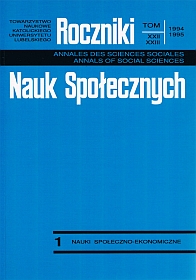Contractual Standard Versus National Standard of the Protection of Human Rights (in Reference to art. 10 § 1 of the International Pact of Citizen and Political Rights)
Abstract
The study discusses the problem of the relation between the international standard of protection, defined in an international contractual regulation, and the national pattern of protection of a selected law of the group of human rights, which may usually be deduced from statutory regulations. Introducing treaty norms into the national legal order requires that the national authorities which use the law of significant opportunity should accept it. Due to the process of introduction it is highly probable that in the law will occur a "competitive" towards the national regulation norm or norms defining human rights. If, then, we mean to apply the law reliably, this calls for a comparison between the national and "external", international standard of protection. Such a comparison may lead us to state an "equivalent" character of the standards. It may also lead us to state differences in the levels of protection and compel us to choose. The choice of standard should always be the choice of the most convenient one for the individual. This is the only criterium. The choice must be preceded by the indentification of the international standard of protection. The essence of this identifying procedure is to grasp the interpretation of a norm by the parties of a treaty. This procedure is relatively simple if the interpretation’s register is carried out by the members of a treaty, the international organ.
The study analyses general remarks, the document registering the interpretation of the International Pact of Citizen and Political Rights. This document is prepared by the organ entitled to this task by the pact’s parties. It is the Committee of Human Rights. Drawing on the General Remarks concerning art. 10 §1 of the Pact the study seeks to reconstruct the standard "coded" in its dictate. The article orders in a humanitarian way to treat the persons deprived of freedom. The present analysis refers the dictate exclusively to people imprisoned by a legally valid sentence. Both the description of the standard of protection as defined in art. 10 § 1 of the Pact and the overall normative context in which it should be perceived are referred to the binding national regulation. When we compare the two regulations we find an apparent prevalence of the international standard over the national one.
Copyright (c) 1995 Roczniki Nauk Społecznych

This work is licensed under a Creative Commons Attribution-NonCommercial-NoDerivatives 4.0 International License.


